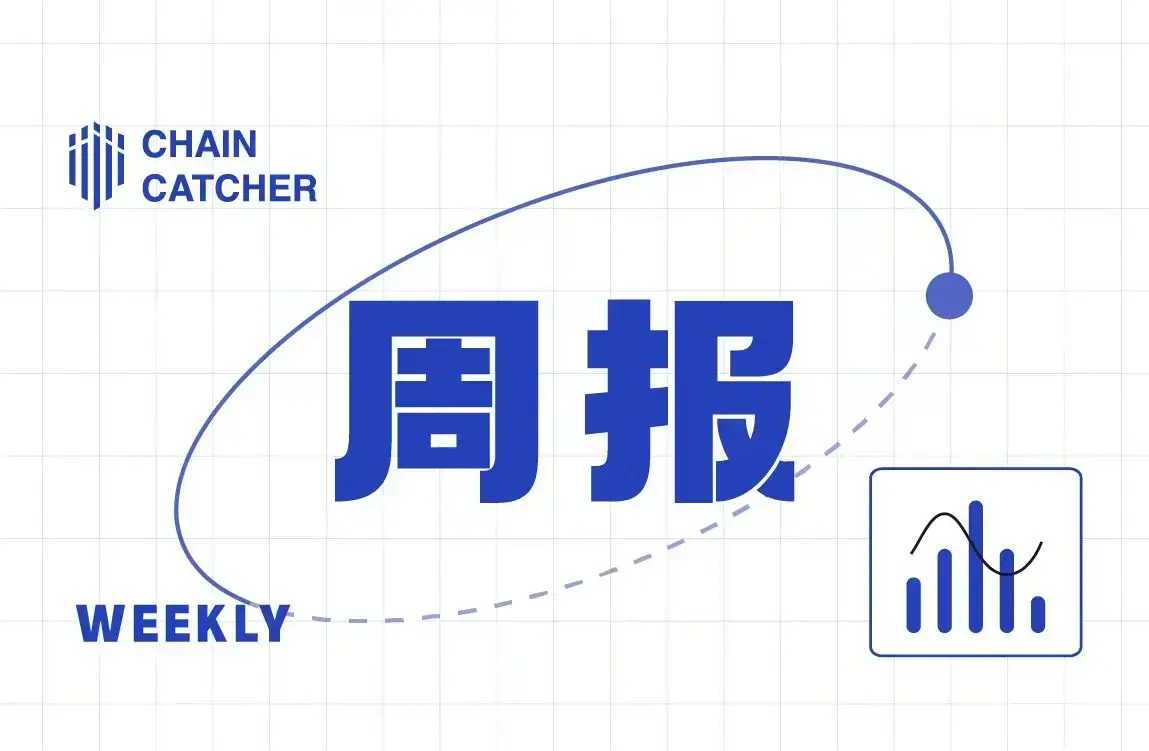How Colony Accelerates the Development of the Avalanche Ecosystem through DAO
Source: Foresight Research
1. Investment Logic
Bet on Avalanche: Highly adaptable consensus mechanism provides unlimited scalability, with immense ecological potential
Choose Community: The paradigm shift in market investment stems from the community spirit of DAOs
Bind Ecology: Provide node liquidity for long-term ecological development
Value Capture: One-stop access to the growth benefits of the Avalanche ecosystem

2. Born from the Community
The pandemic since 2020 has given rise to an era of extremely loose monetary policies. After institutions gained massive funds within the traditional financial system, they began investing in cryptocurrencies as a macro hedge. Tech giants with top-tier resources also started investing in the crypto market. Institutions entering the market have made the crypto space increasingly crowded, driving up the prices of crypto assets, making it harder for individual participants to establish themselves in this market.
Colony's Ecosystem Farming provides community members with the opportunity to participate in Avalanche's primary market investments, returning opportunities that were previously exclusive to institutional investors back to community members. Through the DAO model, rights are returned to community members, and the value created is passed on to them.
3. A Hardcore Technical Team Fuels the Rapid Development of Avalanche
Public chains are like the infrastructure of a city, providing the energy, transportation, and communication functions necessary for the city's operation, allowing for various commercial, social, and entertainment activities, creating application scenarios for users and attracting them to form an economic system. Led by Turing Award winner Professor Emin Gün Sirer, the team at Avalanche offers a new public chain design solution, providing new space for developers and users pursuing performance.
Adaptable Third-Generation Consensus Mechanism
Avalanche has created a brand new consensus mechanism. Previous consensus algorithms were mainly divided into the Classical consensus mechanism, which relies on multi-round voting by all nodes in the network, and the Nakamoto consensus mechanism, which relies on Proof of Work (PoW). The classical consensus mechanism faces scalability issues as the network expands.
The operational costs of nodes in the network begin to grow significantly (often proportional to the square of the number of nodes n), limiting the growth space of the network and making it unable to support larger networks with more users. The decentralized Nakamoto consensus algorithm can scale the network to support a large number of users. However, the random entry and exit of miner nodes can affect block generation speed, leading to lower efficiency.
Professor Emin Gün Sirer, who specializes in distributed systems at Cornell University and is a Turing Award winner, along with Ted Yi, who contributed to the Libra consensus algorithm as the first author, and cryptography PhD Kevin Sekniqi, designed Avalanche's "third-generation consensus protocol" based on metastability and repeated random sampling.
Metastability refers to a system that does not maintain a specific stable state but begins random sampling to reach consensus when voting is required. Therefore, the node threshold for Avalanche is relatively low; anyone can become a node by staking 2,000 AVAX, ensuring decentralization while also reducing energy consumption.
Avalanche's consensus is based on probabilistic random sampling, with the number of samples depending on the size of the network. However, compared to classical consensus mechanisms, the complexity is controllable (proportional to a logarithmic function, with a lower order than a linear function). Connor Daly, founder of Pangolin, stated that the probability of a node repeatedly sampling and arriving at an incorrect conclusion is extremely low, below 0.0000000001%.
By continuously sampling different node samples, after a certain number of times, it will be found that these results tend to converge, making the final result impossible to reverse. It’s like starting with a single snowflake, but through the process of snowballing, it forms an avalanche, hence the name Avalanche protocol.
The configurable Avalanche consensus mechanism gives developers the opportunity to choose nodes and adjust network parameters for security or performance. A large number of developers have been attracted to join the construction of this ecosystem due to Avalanche's mechanism. For example, Connor Daly, founder of DEX Pangolin, has raised the network's security performance to the point where 80% of nodes must collude to pose a threat to network security, meaning that more than 80% of nodes provide different answers.
Three-Chain Architecture: Innate Scalability
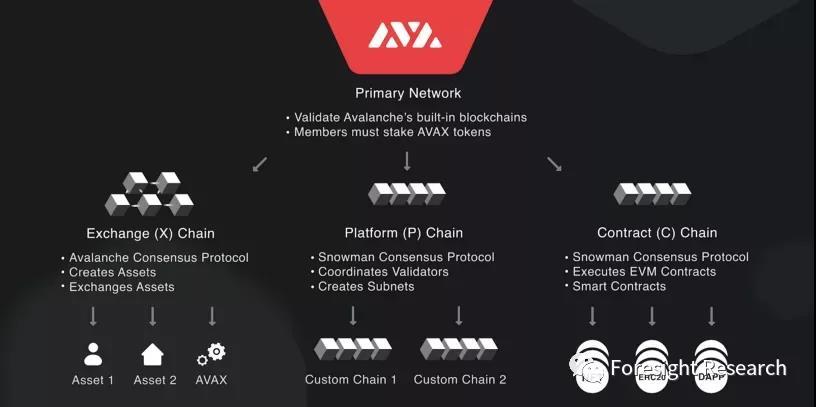
Avalanche Network Architecture
Avalanche's network architecture employs a three-chain parallel structure, consisting of the X-Chain for creating and exchanging assets, the C-Chain for smart contracts that are EVM-compatible, and the P-Chain for coordinating and monitoring validators and creating subnets. The Avalanche system, composed of three interconnected blockchains, provides a scalable foundation from the blockchain architecture design, with categorized functions preventing the main chain from being overloaded by different demands.
Without sacrificing decentralization, the blockchain can choose two methods of scalability:
Vertical scalability by improving the efficiency of data structures or requiring higher-performance hardware to increase blockchain transaction processing speed, but still encountering storage bottlenecks for smart contract calls.
Horizontal scalability by increasing the number of blockchains, deploying multiple parallel chains, theoretically without limit, but requiring interoperability between independent parallel chains.
The Subnet supported on Avalanche's P-Chain opts for horizontal scalability. Subnets need to process transactions through virtual machines, and Avalanche supports various virtual machines, including EVM, Bitcoin Script VM, Cardano's UTXO model, Solana's transaction engine, etc., providing users with cross-chain asset liquidity. While EVM has strong network effects, we may expect innovation from developers.
Compared to open-source public blockchains, subnet designers can adjust the set of validating nodes to determine the visibility and access permissions of the subnet, ensuring the security and privacy of customized protocols. Only validating nodes that meet the standards can send transactions, view on-chain content, and download blocks. Additionally, subnets on the P-Chain can customize GAS fee standards while coordinating and monitoring validators through the P-Chain, directly benefiting from efficiency support from the public chain environment.
4. How Colony Becomes a Core Builder of the Avalanche Ecosystem
Colony, as the first community-driven project incubator in the Avalanche ecosystem, contributes to the market's Beta returns while enhancing the potential returns of projects.
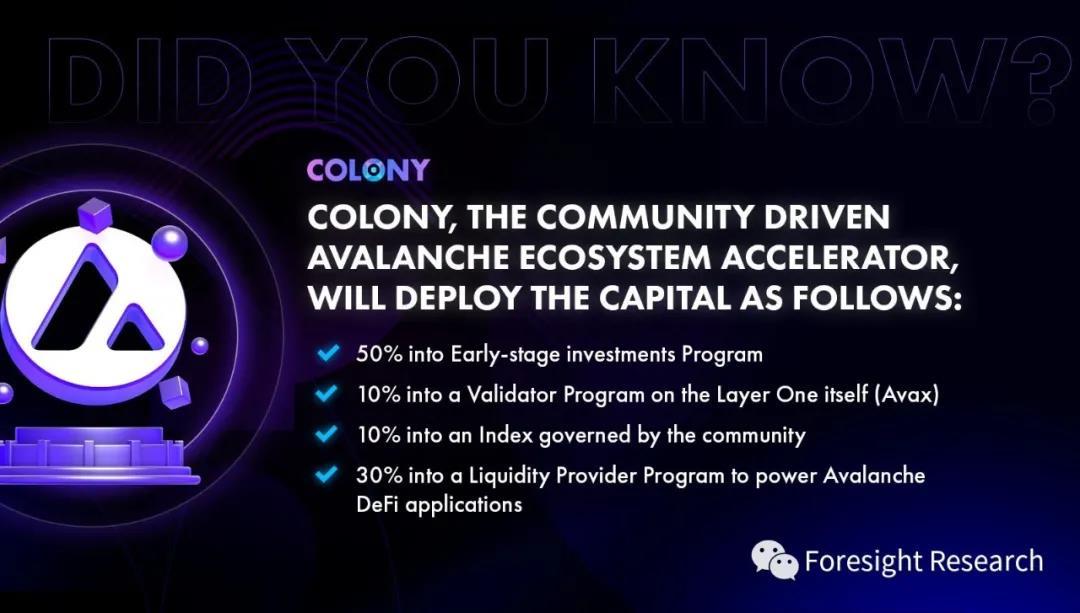
Colony will build the ecosystem from four directions:
1. Become Nodes: Positive Cash Flow Endows Tokens with Intrinsic Value
10% of Colony's net asset value is used to stake nodes. With a fundraising of 20 million, 2 million dollars are available. Assuming the nodes meet the standards for a year, maintaining an online rate of 80%, and AVAX stays at 119 dollars, we can calculate:
Colony holds 16,806.7 AVAX * average annual yield of 9.82% displayed on Avascan = 1,650.42 AVAX (here we ignore the possibility of Colony earning from delegating to other people's nodes).
For convenience, we ignore the volatility of AVAX tokens:
CLY investors can obtain 1,650.42 AVAX * 119 dollars / 10,500,000 market circulation = 0.018 dollars EPS.
From the perspective of mining revenue alone, we can simply compare Colony's valuation with the EPS of existing mining companies and the TTM-PE rolling price-earnings ratio:

Investors have given mining-type stocks a price-earnings ratio estimate of 20-130 times, with the market assigning different prices based on various mining capabilities and strategies. Colony's mining business can refer to the market's price-earnings ratio valuation, combined with the appreciation potential of AVAX tokens, suggesting that CLY holders may offer a higher price-earnings ratio, indicating that investors are willing to pay a higher premium for future growth expectations of Avalanche.
Of course, the returns from liquidity mining have many uncertain factors, including the chosen DEX, trading pairs, and the value fluctuations of AVAX. Here, a rough estimate of Colony's income as an LP on Avalanche may differ significantly from actual income, but it can be seen that Colony's future cash flow income is also quite considerable.
2. Provide Liquidity for DEX: Obtain Funds to Repurchase Tokens for the Community, While Enhancing Ecological Value
30% of Colony's net asset value provides liquidity in the DeFi market, which amounts to 20 million dollars * 30% = 6 million dollars. Assuming Colony provides liquidity on leading DEXs on Avalanche, Trader Joe and Pangolin, averaging 3 million dollars each.
Assuming Colony, as a large LP, chooses top liquidity pools to obtain stable returns, for example, the token yield APY for USDC.e-WAVAX is 16.29%, and the fee income APY is 30.59%, yielding liquidity mining of 487,000 + fee income of 917,700, totaling 1,406,700 dollars.
In Pangolin, selecting top liquidity pools, for example, WETH.e-WAVAX, the fee APY is 15%, plus mining income of 4%, yielding an annual APY income of 19%, resulting in an income of 570,000 dollars for Colony within a year.
Conservatively calculating, as an LP, the total income is 1,976,400 dollars. At a price of 1.67 dollars, Colony can repurchase 1,183,400 CLY tokens, accounting for 11.2% of the publicly issued 10,500,000 tokens. Furthermore, subsequent income will continue to be reinvested for token repurchases.
At the same time, Colony's contribution to Avalanche's TVL can be referenced through the TVL ratio for potential value. As of December 22, according to data from Defi Llama and CMC, the total TVL of DeFi is 249.89 billion dollars, of which:
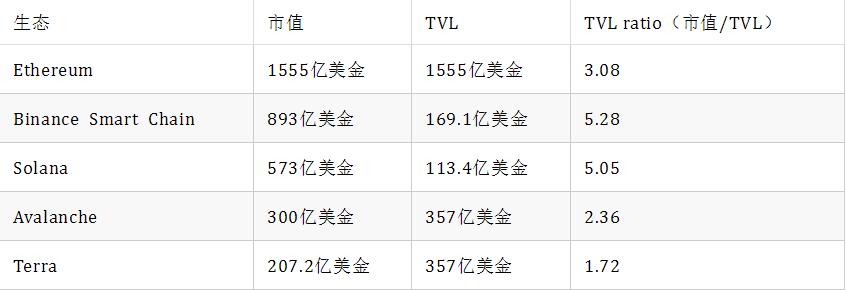
The TVL ratio is the ratio of market capitalization to TVL, which helps determine whether DeFi assets are overvalued or undervalued. Avalanche ranks among the top five public chains in TVL, with its TVL ratio only slightly higher than the lowest Terra, indicating that AVAX is relatively undervalued compared to other assets.
Assuming the price of AVAX remains unchanged, it indicates that Avalanche is a continuously undervalued asset, suggesting more room for valuation correction from a valuation perspective. If the price of AVAX rises, the TVL ratio decreases, which may be due to TVL attracting more funds, causing an economic siphoning effect.
3. Avalanche Ecological Index Fund: Capturing the Market Value Beta of Avalanche's Growth
Currently, Colony has not yet launched an index fund, but we can estimate potential revenue based on existing index investment business models.
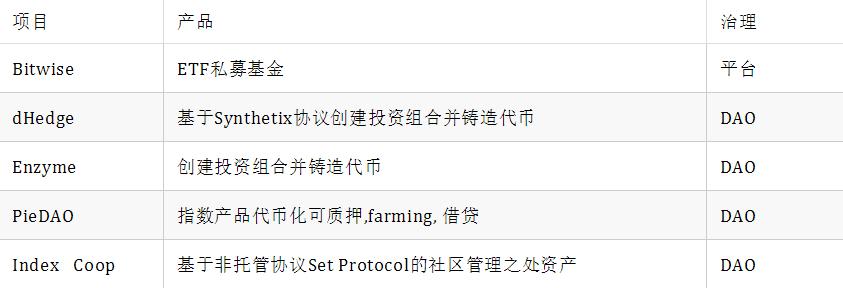
Index Coop currently has five types of indices, among which the Leverage product is a leveraged product targeting a specific ecosystem, such as the ETH 2X Flexible Leverage Index.
The Leverage product index targeting ETH is quite similar to the Avalanche-exclusive ecological fund launched by Colony. Although the Avalanche ecological fund provided by Colony will not offer leverage, the covered investment groups are more similar, so we benchmark against the income valuation of ETH2X.
Index Coop reported revenue of 723,710 dollars for November, with total revenue of 1.88 million dollars over three months since the protocol's inception until November. The Ethereum fund ETH2x-FLI, which is primarily leveraged, contributed 58% of the revenue.
The number of index investors has grown from fewer than 5,000 at the beginning of the year to over 30,000 holders in December, with TVL reaching 500 million dollars in the past month. This indicates that index investment products are gaining increasing favor among investors, with more individual and institutional investors beginning to consider joining index investments for stable long-term returns.
As the first to launch an Avalanche ecological index fund, Colony can expect more first-mover advantages to attract more investors to participate in index investments. It is also important to note that the composition structure of the index fund, the way value is anchored, management fees, etc., are all issues that the Colony community needs to consider.
4. Primary Market Investment: Focused Ecological Investment Covering Multiple Tracks
Colony is deeply bound to the Avalanche ecosystem and can access more primary market resources through official partnerships, laying out in various tracks.
Colony has publicly invested in seven projects:
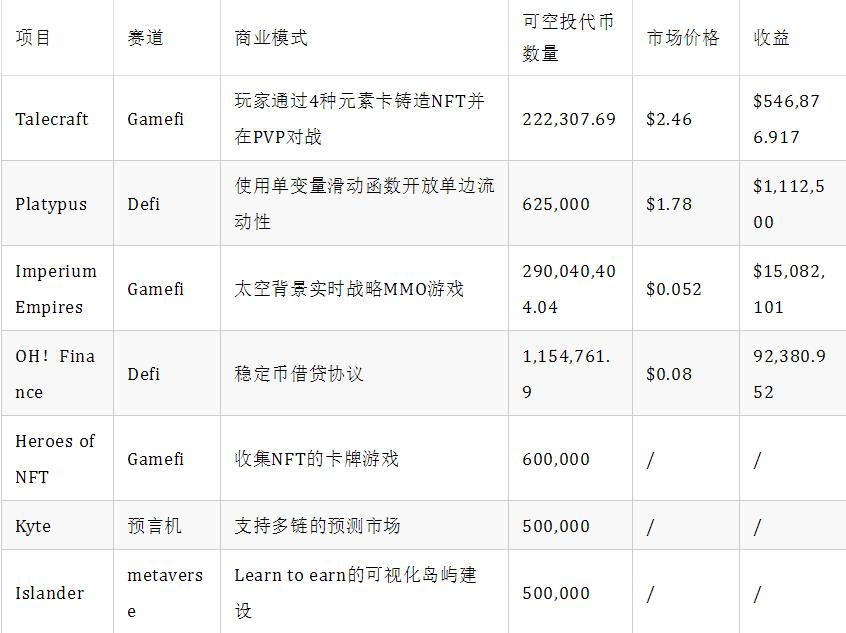
Based on market prices, excluding projects without TGE, Colony's primary market returns have already reached 16,833,858.9 dollars, all of which can be obtained through holding CLY tokens for airdrops, with the current market price costing 1.67 dollars.
It is also important to note that Colony's investment decisions are still centralized, and attention needs to be paid to the details of community voting governance in the future.
Colony's four major businesses will bring relatively stable cash flow income, endowing CLY tokens with intrinsic value, making CLY tokens assets that can continuously generate economic returns. However, most crypto assets rely on market hype and narratives, lacking intrinsic value, leading to significant price fluctuations driven by speculative traders.
Even without considering the returns from primary market investments, Colony's three businesses can provide real-time insights into Colony's cash income through publicly transparent on-chain data. Whether participating in governance as a DAO member or holding such tokens, the tokens represent ownership, meaning the right to obtain economic benefits.
5. Strength of a Trading Team from Mature Markets
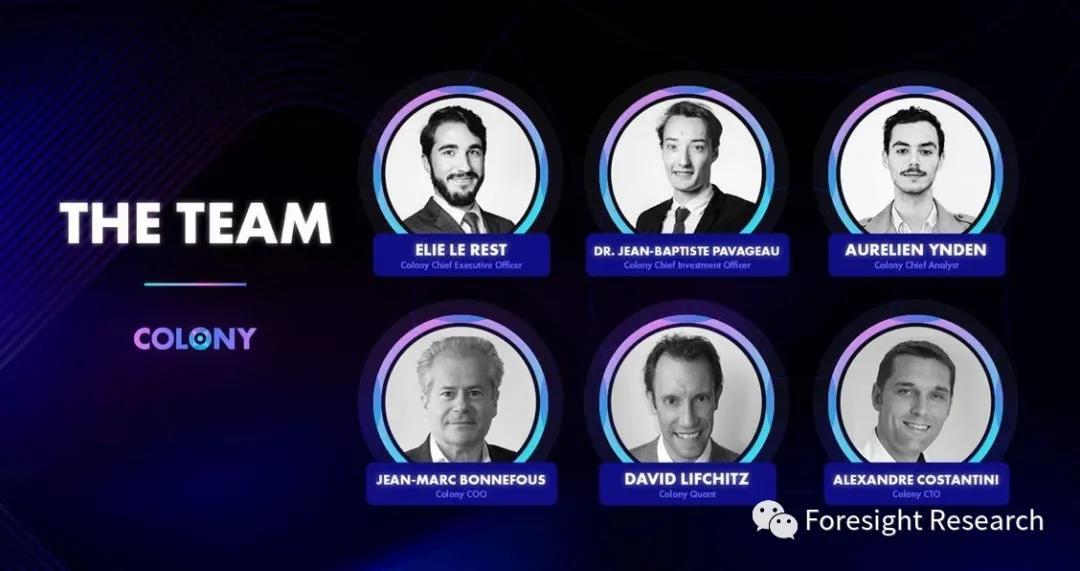
Colony's founding team comes from traditional finance trading backgrounds and the world's top former IBM technical team. Their trading experience from mature markets gives them a deeper understanding of risk and return.
CEO Elie le rest invested in digital assets in 2014 and established the quantitative hedge fund ExoAlpha in 2019, managing up to 500 million dollars.
CIO Dr. Jean-Baptiste has been engaged in quantitative trading since 2015, co-founding Olymp Capital and Olymp Fund, achieving a 44% IRR, and managing ExoAlpha alongside CEO Elie.
COO Jean-Marc Bonnefous served as CEO at the private equity firm Tellurian Capital in the commodity market in 2007 and was the global head of commodity and derivatives trading at top European investment bank BNP Paribas, accumulating 15 years of trading experience. CTO Alexandre Costantini led software architecture at IBM.
David Lifchitz, quantitative trading manager, serves as the risk control director for the US market at the private equity firm Ashmore Group, managing over 90 billion dollars.
The development team also includes developers with Solidity development experience, and advisors such as Nicolas, general manager of Avalab, Mark, CEO of Avalanche, and Dave, a partner at Avalanche, have joined the team for deep collaboration with Avalanche.
6. Token Economics
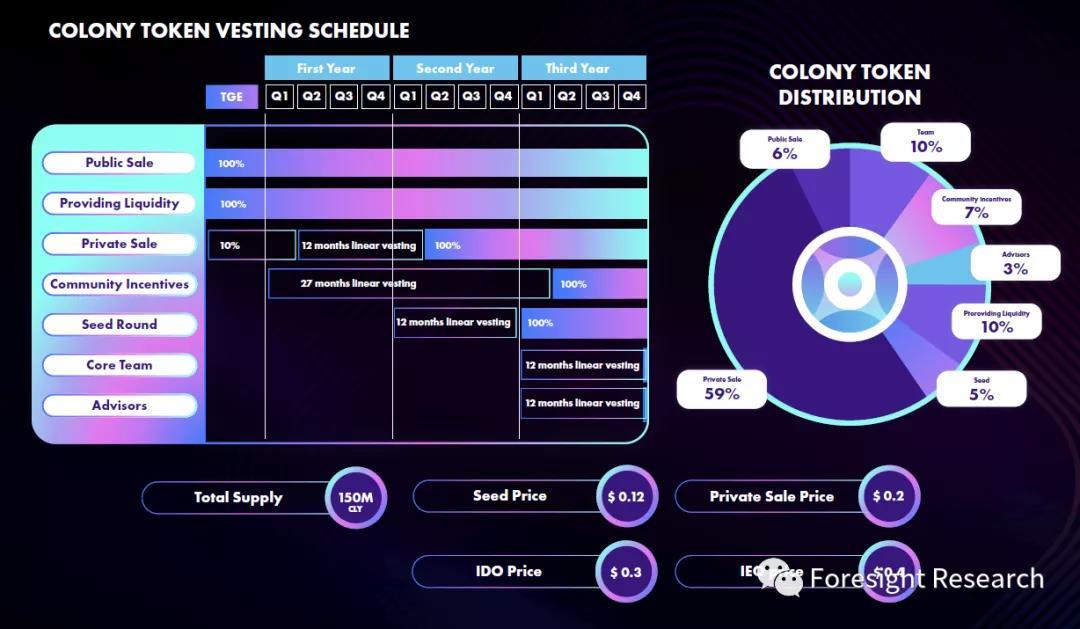
Colony has set the record for the highest fundraising in Avalanche, raising over 20 million dollars. The team's plan is to cover more users from the start, giving every ordinary user the opportunity to participate.
Token Distribution: The total issuance of CLY is 15,000,000, with 70% of the tokens already sold in the public market. The remaining distribution details are as follows:

Financing Situation: A total of 21 million dollars was raised in private and public rounds, selling 70% of the tokens. Initial circulation: 16.6 million CLY (excluding liquidity tokens). Initial market value: 6.6 million dollars (based on an IEO price of 0.40 dollars, excluding liquidity tokens):
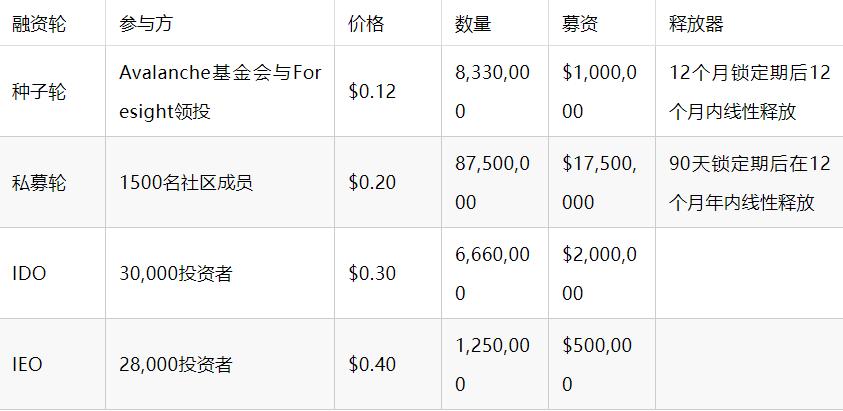
With over 10,000 token holders and an additional 20,000 stakers, these users will ultimately become airdrop recipients of early investment projects as early supporters. Community members who start staking now can receive the first batch of airdrops, including TaleCraft, Platypus, and Imperium Empires, starting at the end of December this year.
CEO Elie publicly displayed Colony's public fundraising situation on Twitter, with over 13 million tokens staked and a TVL of approximately 35 million dollars, ranking in the top 20 on Avalanche.
Token Value: Stock-like Asset
1. Become an Early Investor in Projects, Capturing Value Growth through CLY Tokens.
The DAO's tokens are a direct representation of the portfolio's value. Holding tokens means holding the value of investing in the DAO system, truly empowering community members with the value of holding tokens. Encouraging long-term investment through the project value represented by the tokens stabilizes token value. At the same time, it incentivizes secondary market investors to hold tokens, obtaining returns from primary market investments, significantly reducing the cost of holding multiple projects. Additionally, Colony's deep binding relationship with Avalanche means that holding CLY also indirectly holds the value growth of the Avalanche ecosystem.
2. Staking Provides Triple Rewards, Encouraging Long-term Value Investment
Staking tokens allows more tokens to settle in the fund pool, stabilizing long-term value. Staking CLY tokens can yield:
a. Node staking rewards
b. LP liquidity rewards
c. Project token airdrop rewards
CLY holders need at least 50 CLY tokens (the threshold requirement of 50 CLY may be adjusted or lowered through DAO community governance) and must lock them for 20 days. Community members who stake for less than 20 days will not be eligible for the upcoming airdrop rewards. If staking is canceled within 20 days, the staking days will reset to 0, requiring a restart.
Colony's staking mechanism encourages long-termism. As an early investor in the Avalanche ecosystem, Colony's staking lock-in period reflects their commitment to a long-term vision, considering the community's long-term development while ensuring stability to support the growth of the Avalanche ecosystem.
7. Investment Institutions
Seed funding of 1 million dollars was led by Foresight Ventures, Avalab, and GBV. Avalabs, as the official investment fund of Avalanche, is managed by a team of US LPs, with very few primary market investment projects, indicating a strong fit between the project party and the ecological party.
GBV Capital is also an investment institution under Genesis Block, which operates one of the largest cryptocurrency OTC trading platforms. Other investment institutions include Avalaunch, Avatar, Yield Yak, NGC Ventures, Spark Digital Capital, MEXC Global, Synaps, and ZBS Capital.

Foresight Ventures focuses on long-term value investment, supporting innovative and disruptive Web 3.0 projects. We believe that crypto technology will define future development, and Colony is redefining the investment paradigm in the primary market. By incubating Avalanche through the community, we have decided to support investment and provide extensive support from our ecosystem.
8. Competitive Analysis
Colony's community-based participation in primary market investments requires attracting funds from ordinary investors. The existing market has already seen the emergence of on-chain asset management protocols to assist traders.
Secondary Market Asset Management Platforms: Examples include Enzyme and dHEDGE
Enzyme: Circulating Market Cap 145 million dollars, Fully Diluted Market Cap 148 million dollars
As an asset management protocol, it allows anyone to create investment portfolios or choose to join funds created by others based on market performance. Enzyme provides a market for investors to choose or create their own funds, primarily trading in the secondary market, with a backend composed of a set of smart contracts that automatically execute investment, redemption, asset custody, trading, fee distribution, and other functions, replacing traditional funds. Essentially, Enzyme is more like a fund supermarket.
dHEDGE: Circulating Market Cap 145 million dollars, Fully Diluted Market Cap 148 million dollars
dHEDGE is also a fund supermarket based on the Synthetix ecosystem. When fund managers create investment portfolios, they mint new fund tokens, and investors receive tokens in proportion to their shares. Investors can redeem tokens and proportionally allocate the fund's assets.
dHEDGE plans to allow investors to redeem fund tokens for a single asset, not just their investment share in the fund's portfolio. When the managed fund's returns exceed previous peaks, fund managers can charge fees and mint new tokens, thereby expanding their share in the fund pool, which may dilute investors' shares.
dHEDGE trades through synthetic assets and the Synthetix protocol in liquidity pools on Ethereum and Polygon, so fund managers may lack hedging tools like futures or options, and trading strategies are not publicly transparent.
9. Conclusion
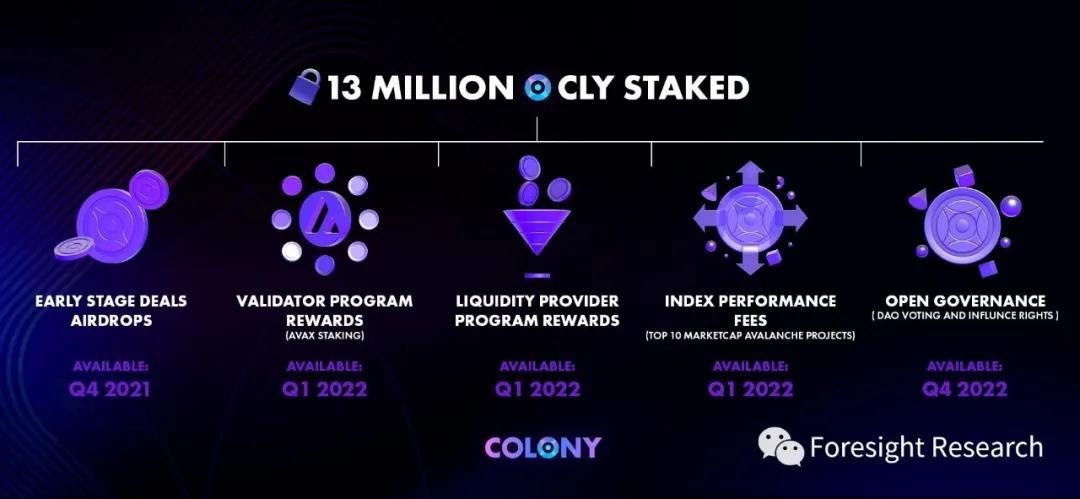
Unlike existing asset management, Colony offers investment opportunities in the primary market that were previously limited to institutional investors or KOLs. This presents sufficient attraction for ordinary users who want to participate in the primary market but lack funds and access; they only need to join the DAO or hold CLY tokens to gain primary market returns while indirectly holding the value growth potential of the Avalanche ecosystem.
As an incubator for Avalanche, Colony relied on a centralized team to invest in the primary market before achieving DAO status in 2022. With deep collaboration with the Avalanche ecosystem, the project resources and the incubation capabilities of the underlying community make them particularly significant as the first community-based primary market investor.
At the same time, as participants in the primary market, Colony and its investors must bear project risks in addition to the existing market risks and accept a longer lock-in period for funds, requiring a longer maturation period for investors primarily trading in the secondary market.
As an investment DAO focused on the Avalanche ecosystem, Colony participates in the construction of the Avalanche ecosystem through community-driven efforts. As a DAO, Colony redefines its contributions as an incubator to the ecosystem and projects, from early investment in projects to enriching the ecosystem's application scenarios, to actually maintaining the ecosystem as an Avalanche node.
Colony, within a public chain ecosystem, serves both as a builder contributing market value beta and as a community DAO investing in primary projects. And this is just the beginning; Colony's vision is to launch a global platform encompassing investment, incubation, and trading.








